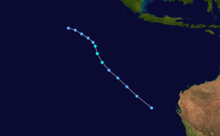1987–88 Australian region cyclone season
1987–88 Australian region cyclone season
| |
| Season summary map |
| First system formed |
6 December 1987 |
| Last system dissipated |
20 May 1988 |
| Strongest storm1 |
Gwenda-Ezenina – 940 hPa (mbar), 155 km/h (100 mph) (10-minute sustained) |
| Tropical lows |
6 |
| Tropical cyclones |
5 |
| Severe tropical cyclones |
2 |
| Total fatalities |
1 |
| Total damage |
$17.9 million (1988 USD) |
| 1Strongest storm is determined by lowest pressure |
Australian region tropical cyclone seasons
1985–86, 1986–87, 1987–88, 1988–89, 1989–90 |
| Related articles |
|
|
The 1987–88 Australian region cyclone season was an event in the cycle of tropical cyclone formation. It officially started on 1 November 1987, and officially ended on 30 April 1988. The regional tropical cyclone operational plan defines a "tropical cyclone year" separately from a "tropical cyclone season"; the "tropical cyclone year" began on 1 July 1987 and ended on 30 June 1988.[1]
Seasonal summary
Storms
Tropical Low Ariny
| Tropical low (Australian scale) |
|
|
| Duration |
6 December – 9 December (Exited basin) |
| Peak intensity |
55 km/h (35 mph) (10-min) |
Tropical Cyclone Agi
| Category 2 tropical cyclone (Australian scale) |
| Category 1 tropical cyclone (SSHWS) |
|
|
| Duration |
6 January (Entered basin) – 14 January (Exited basin) |
| Peak intensity |
95 km/h (60 mph) (10-min) 980 hPa (mbar) |
Cyclone Agi veered away from the main islands of Papua New Guinea's Milne Bay province yesterday after flattening many buildings, uprooting trees and disrupting water supplies. Agi brought heavy rain, high tides and winds gusting at more than 100 km/h to the remote islands it brushed at the eastern tip of the PNG mainland since it formed and began to swirl through the area on Sunday.
Severe Tropical Cyclone Frederic
| Category 3 severe tropical cyclone (Australian scale) |
| Category 1 tropical cyclone (SSHWS) |
|
|
| Duration |
28 January – 2 February |
| Peak intensity |
150 km/h (90 mph) (10-min) 955 hPa (mbar) |
Frederic, 28 January to 2 February 1988, Indian Ocean
Severe Tropical Cyclone Gwenda-Ezenina
| Category 4 severe tropical cyclone (Australian scale) |
| Category 2 tropical cyclone (SSHWS) |
|
|
| Duration |
6 February – 12 February Out of area |
| Peak intensity |
160 km/h (100 mph) (10-min) 941 hPa (mbar) |
Gwenda-Ezenina, 6 to 12 February 1988, Indian Ocean
Tropical Cyclone Charlie
| Category 2 tropical cyclone (Australian scale) |
| Tropical storm (SSHWS) |
|
|
| Duration |
19 February – 1 March |
| Peak intensity |
115 km/h (70 mph) (10-min) 972 hPa (mbar) |
Charlie struck Ayr, Queensland in March 1988, killing one person and leaving $2,300,000 dollars (1988 USD) in damage.
Tropical Cyclone Herbie
| Category 1 tropical cyclone (Australian scale) |
| Tropical storm (SSHWS) |
|
|
| Duration |
17 May – 20 May |
| Peak intensity |
75 km/h (45 mph) (10-min) 990 hPa (mbar) |
Herbie, 17 to 20 May 1988, Indian Ocean
See also
- Atlantic hurricane seasons: 1987, 1988
- Eastern Pacific hurricane seasons: 1987, 1988
- Western Pacific typhoon seasons: 1987, 1988
- North Indian Ocean cyclone seasons: 1987, 1988
References













